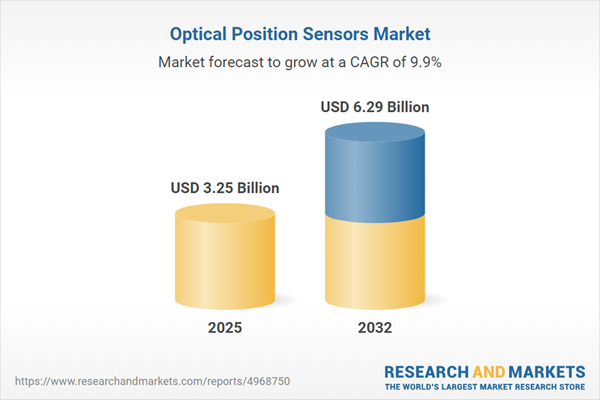Speak directly to the analyst to clarify any post sales queries you may have.
Optical position sensors are shaping the future of advanced motion control and measurement, giving senior decision-makers a reliable pathway to improved accuracy and robust operational outcomes for high-value industrial sectors. Their application potential spans diverse markets, making them fundamental to automation strategies at scale.
Market Snapshot: Optical Position Sensors Market
The global optical position sensors market is maintaining strong momentum, fueled by demand for technologies that deliver high-precision measurement and robust control in automated processes. Developments in miniaturized optical components and advanced semiconductor integration are broadening operational capabilities, positioning these sensors as critical to the evolution of industrial automation, robotics, aerospace, and next-generation consumer electronics. Rapid digital transformation and innovative manufacturing models continue to reinforce sector growth, as companies prioritizing reliability and flexibility in automation turn to these solutions for enhanced performance and resilience in increasingly data-driven environments.
Scope & Segmentation
This comprehensive market research report maps the landscape of optical position sensors, providing actionable segmentation and strategic insight tailored for leadership teams navigating technology shifts and evolving operational agendas:
- Sensor Type: Contact and non-contact formats offer adaptability to varied environments and equipment designs, meeting diverse operational needs across industries.
- Technology: Solutions span optical encoders—both absolute and incremental, optical potentiometers, reflective optical sensors, and through-beam optical sensors, each supporting a range of precision, integration, and space constraints.
- Output Type: Sensors with analog and digital outputs address the requirements of original equipment manufacturers and system integrators looking for compatibility and scalability.
- Application: Use-cases cover aerospace and defense, advanced automotive platforms (including driver assistance, infotainment, and powertrain), consumer electronics (cameras, wearables), healthcare (diagnostic, monitoring, and surgical equipment), and industrial automation in robotics, CNC machinery, and packaging. Each vertical has distinct demands for speed, resilience, and regulatory conformity.
- End Use Industry: Aerospace and defense, automotive, consumer goods, manufacturing, and medical sectors highlight extensive market reach and necessitate bespoke technical adaptations to meet unique sector standards.
- Region: Americas (United States, Canada, Mexico, Brazil, Argentina, Chile, Colombia, Peru), Europe, Middle East & Africa (key countries include United Kingdom, Germany, France, Russia, Italy, Spain, Netherlands, Sweden, Poland, Switzerland, United Arab Emirates, Saudi Arabia, Qatar, Turkey, Israel, South Africa, Nigeria, Egypt, Kenya), Asia-Pacific (China, India, Japan, Australia, South Korea, Indonesia, Thailand, Malaysia, Singapore, Taiwan) comprise established and emerging markets, each offering unique growth enablers and operational challenges.
- Leading Companies: The competitive landscape features Honeywell International Inc., TE Connectivity Ltd., Infineon Technologies AG, STMicroelectronics N.V., Texas Instruments Incorporated, Broadcom Inc., ams OSRAM AG, NXP Semiconductors N.V., Renesas Electronics Corporation, and Sensata Technologies Holding plc, collectively driving innovation and fostering strategic alliances that shape sector advancement.
Key Takeaways for Senior Decision-Makers
- Deployment of optical position sensors directly supports higher operational efficiency, empowering continuous improvement in digitalized production and reducing unplanned downtime.
- MEMS technologies and advances in silicon photonics are enabling new use-cases, furthering sensor deployment in compact devices integral to both healthcare and consumer electronics workflows.
- Non-contact optical sensor designs are extending hardware lifecycles, offering major advantages in environments where device reliability and minimal maintenance are paramount.
- Growth in Asia-Pacific is creating shifts in supply chains and competitive dynamics, while evolving standards across EMEA prompt redesigns to ensure regulatory compliance and sustainable procurement.
- Strategic collaboration and increased vertical integration among leading suppliers are facilitating access to advanced photonics capabilities and greater supply chain resilience, helping organizations mitigate sourcing risk from geopolitical change.
Tariff Impact on Supply Chain Strategy
Recent tariffs enacted in the United States have led manufacturing organizations to revisit sourcing and inventory management. Responding to rising import duties on optical and semiconductor components, companies are diversifying supplier networks across additional geographies and pursuing longer-term agreements. These shifts help manage cost pressures, maintain consistent supplies, and support business continuity for critical operations—especially as global trade relationships remain uncertain.
Methodology & Data Sources
This study bases its findings on interviews with senior industry and technical stakeholders, supported by review and validation of technical literature, regulatory filings, and current market benchmarks. The research process integrates data triangulation and expert workshops, ensuring robust reflection of actual and emerging sector conditions.
Why This Report Matters
- Achieve deeper visibility into technology trends, supplier dynamics, and region-specific adoption—informing decisions on capital allocations and technology partnerships.
- Identify the primary output types and application segments to better align procurement and design choices with current and forthcoming compliance standards.
- Leverage targeted analysis of partner ecosystems and global supply dynamics, strengthening your organization’s competitive position and supporting sustainable growth objectives.
Conclusion
Optical position sensors are fundamental to unlocking the next stage of automation and predictive maintenance. This market intelligence delivers actionable analysis, helping leaders keep pace with technological evolution and secure future-ready growth strategies.
Additional Product Information:
- Purchase of this report includes 1 year online access with quarterly updates.
- This report can be updated on request. Please contact our Customer Experience team using the Ask a Question widget on our website.
Table of Contents
3. Executive Summary
4. Market Overview
7. Cumulative Impact of Artificial Intelligence 2025
List of Figures
Samples

LOADING...
Companies Mentioned
The key companies profiled in this Optical Position Sensors market report include:- Honeywell International Inc.
- TE Connectivity Ltd.
- Infineon Technologies AG
- STMicroelectronics N.V.
- Texas Instruments Incorporated
- Broadcom Inc.
- ams OSRAM AG
- NXP Semiconductors N.V.
- Renesas Electronics Corporation
- Sensata Technologies Holding plc
Table Information
| Report Attribute | Details |
|---|---|
| No. of Pages | 198 |
| Published | October 2025 |
| Forecast Period | 2025 - 2032 |
| Estimated Market Value ( USD | $ 3.25 Billion |
| Forecasted Market Value ( USD | $ 6.29 Billion |
| Compound Annual Growth Rate | 9.8% |
| Regions Covered | Global |
| No. of Companies Mentioned | 11 |








